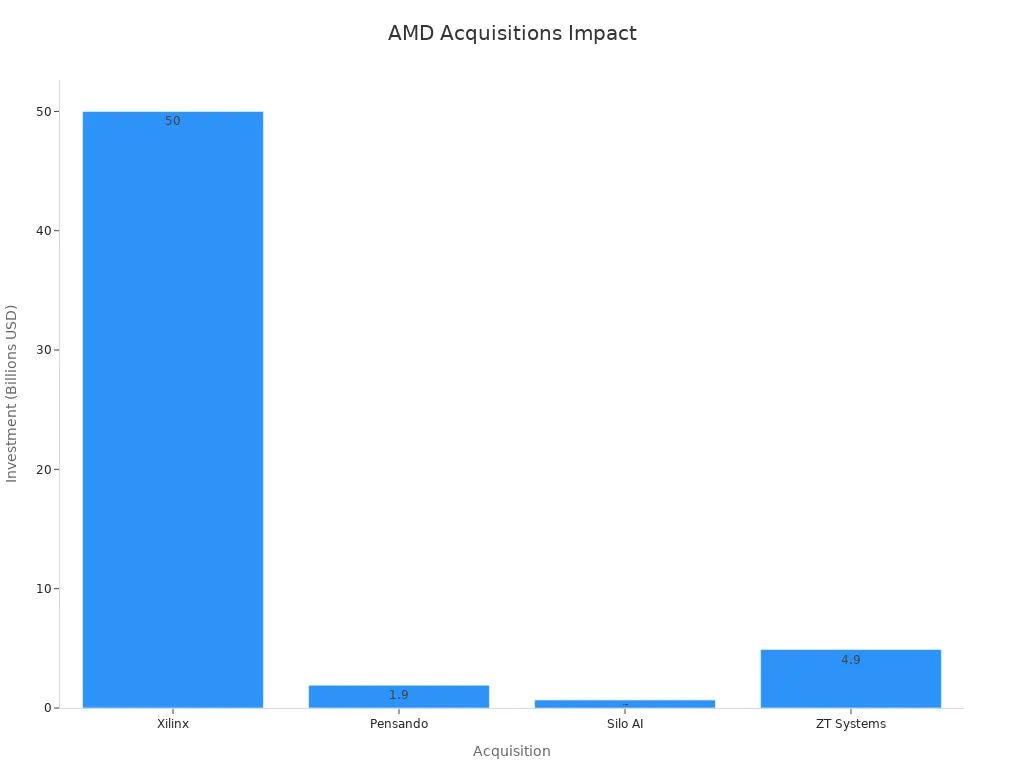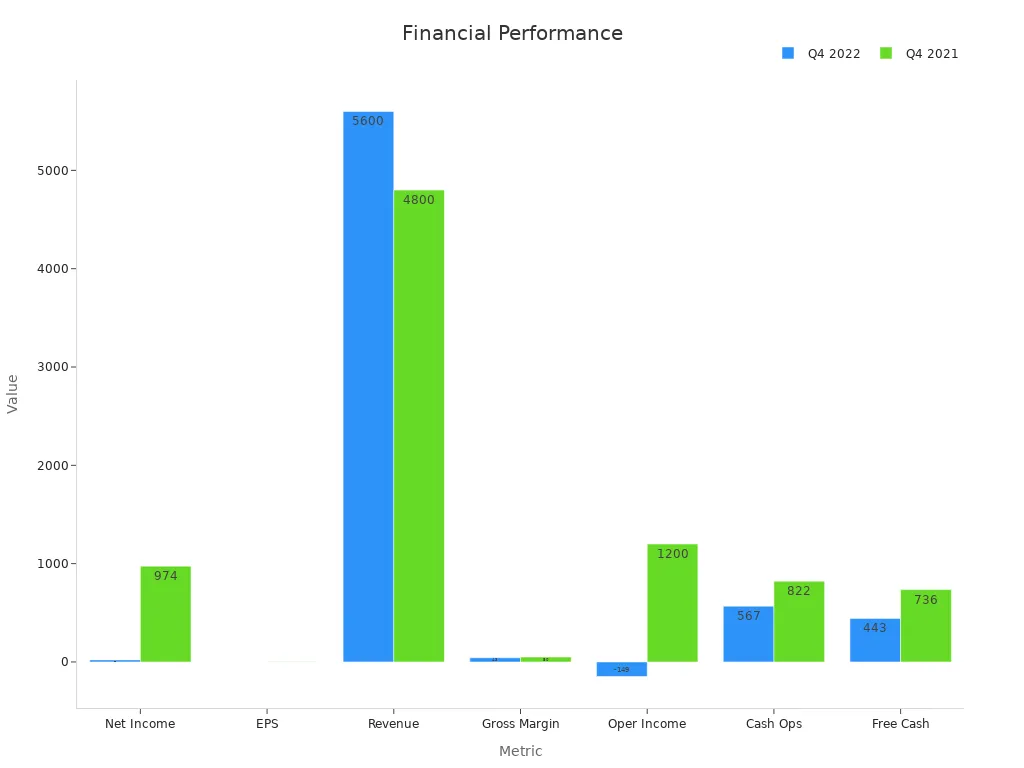How AMD's Acquisitions Shape the Future of AI

AMD's recent acquisitions are transforming its position in the AI landscape, particularly through its AMD AI advancements. By integrating cutting-edge technologies, AMD strengthens its hardware and software ecosystems, fueling AI advancements across industries. These strategic moves enhance its data center capabilities, enabling faster and more efficient AI applications. The company's focus on innovation highlights its commitment to creating robust solutions for the growing demand in AI. With initiatives like the "Advancing AI 2025" event, AMD showcases its vision to redefine the future of AI and solidify its leadership in this rapidly evolving field.
Key Takeaways
AMD's smart purchases boost its AI skills, making AI tools faster and easier to use in many fields.
Using tech from companies like Mipsology and Nod.ai makes AI work better and helps developers build faster.
AMD's focus on data centers has grown its earnings, showing its strong role in AI systems.
Future events like 'Advancing AI 2025' will show AMD's new ideas and next-level AI tools.
By working on new tech like silicon photonics, AMD is ready to lead in AI and help modern industries.
AMD's Recent Acquisitions and Their Role in AI
AMD's strategic acquisitions have played a pivotal role in shaping its AI capabilities. By acquiring companies with specialized expertise, AMD has strengthened its position in the AI chip market and expanded its ecosystem of hardware and software solutions. These acquisitions reflect AMD's commitment to innovation and its focus on delivering optimized AI solutions for diverse industries.
2023 Acquisitions: Mipsology and Nod.ai
In 2023, AMD acquired Mipsology and Nod.ai to enhance its AI software platforms and inference capabilities. Mipsology, known for its advanced AI inference acceleration software, brought tools that optimize AI computing across AMD's hardware. Nod.ai contributed its expertise in AI frameworks, enabling AMD to streamline the development of custom-built AI solutions. These acquisitions allowed AMD to offer developers a more cohesive and efficient AI development environment.
Note: The integration of Mipsology's inference tools with AMD's Instinct GPUs has significantly improved performance in AI workloads, particularly in natural language processing and computer vision tasks.
2024 Acquisitions: Silo AI and ZT Systems
The silo ai acquisition in 2024 marked a major milestone for AMD. Silo AI, a leader in AI model development, provided AMD with advanced platforms for creating and deploying AI solutions. This acquisition accelerated AMD's development of AI infrastructure, aligning with the growing demand for AI technologies. Additionally, AMD acquired ZT Systems, a company specializing in data center solutions, for $4.9 billion. This acquisition expanded AMD's capabilities in building high-performance AI systems for data centers.
AMD's data center segment revenue reached $3.5 billion in 2024, a 122% year-over-year increase, driven by the integration of Silo AI and ZT Systems.
The acquisitions positioned AMD to capture a larger share of the AI infrastructure market, which is projected to grow exponentially in the coming years.

2025 Acquisitions: Enosemi, Brium, and Untether AI
In 2025, AMD continued its acquisition strategy by targeting companies that could enhance its AI computing capabilities. Enosemi brought expertise in photonic integrated circuits, improving data transmission efficiency for next-generation AI systems. Brium, an AI software firm, contributed tools for optimizing AI inference across various hardware architectures. Untether AI added value through its engineering talent and innovations in AI compiler development and system-on-chip (SoC) design.
Acquisition | Description |
|---|---|
Enosemi | Improved data transmission efficiency for AI systems through photonics. |
Brium | Enhanced AI inference software efficiency across hardware architectures. |
Untether AI | Boosted AI compute capacity and infrastructure through engineering talent. |
These acquisitions reflect AMD's investment in cutting-edge technology and talent, ensuring its leadership in the AI chip market. By integrating these companies' capabilities, AMD has positioned itself to deliver high-performance AI solutions that meet the demands of modern industries.
2022 Acquisitions: Xilinx and Pensando
AMD's acquisition of Xilinx and Pensando in 2022 marked a transformative year for the company. These acquisitions strengthened AMD's position in the AI and data center markets, enabling it to deliver cutting-edge solutions for modern computing challenges.
Xilinx, a leader in adaptive computing, brought its expertise in field-programmable gate arrays (FPGAs) and adaptive SoCs to AMD. These technologies enhanced AMD's ability to address diverse AI workloads, from edge computing to data centers. Xilinx's FPGAs provided flexibility and performance, making them ideal for AI inference and training tasks. This acquisition also expanded AMD's portfolio, allowing it to cater to industries such as automotive, telecommunications, and aerospace.
Pensando, on the other hand, specialized in distributed computing and data center acceleration. Its platform offered advanced networking, security, and storage capabilities, which complemented AMD's existing data center solutions. By integrating Pensando's technology, AMD improved the efficiency and scalability of its AI infrastructure, addressing the growing demand for high-performance computing.
The financial impact of these acquisitions was significant. While AMD's revenue increased due to contributions from Xilinx and Pensando, the amortization of intangible assets affected its gross margin. The table below highlights key financial metrics comparing Q4 2022 and Q4 2021:
Metric | Q4 2022 | Q4 2021 | Change |
|---|---|---|---|
Net Income ($M) | $21 | $974 | Down 98% |
Earnings per Share | $0.01 | $0.80 | Down 98.75% |
Revenue ($M) | $5,600 | $4,800 | Up 16.67% |
Gross Margin (%) | 43% | 50% | Down 7% |
Operating Income ($M) | -$149 | $1,200 | Down 112.42% |
Cash from Operations ($M) | $567 | $822 | Down 30.96% |
Free Cash Flow ($M) | $443 | $736 | Down 39.87% |

Despite the short-term financial challenges, the acquisitions positioned AMD for long-term growth. Revenue from the Data Center and Embedded segments grew significantly, driven by the integration of Xilinx and Pensando technologies. The acquisitions also enabled AMD to offer more comprehensive AI solutions, addressing the needs of industries undergoing digital transformation.
In Q2 2022, AMD's financial performance further reflected the impact of these acquisitions. The table below compares key metrics from Q2 2022 and Q2 2021:
Metric | Q2 2022 | Q2 2021 | Change |
|---|---|---|---|
Net Income ($M) | $447 | $710 | Down 37% |
Earnings per Share | $0.27 | $0.58 | Down 53.45% |
Revenue ($M) | $5,890 | $3,850 | Up 53.03% |
Gross Margin (%) | 46% | 48% | Down 2% |
Operating Income ($M) | $526 | $831 | Down 36.66% |
Cash from Operations ($M) | $1,040 | $952 | Up 9.23% |
Free Cash Flow ($M) | $906 | $888 | Up 2.03% |
The acquisitions of Xilinx and Pensando allowed AMD to enhance its AI capabilities and expand its market reach. Xilinx's adaptive computing technology and Pensando's data center expertise complemented AMD's existing strengths, creating a robust ecosystem for AI innovation. These strategic moves underscored AMD's commitment to shaping the future of AI and maintaining its competitive edge in the industry.
Strategic Impact of AMD's Acquisitions
Enhancing AI Inference and Frameworks
AMD's acquisitions have significantly improved its AI inference capabilities and frameworks, enabling developers to create optimized AI solutions. The integration of Nod.ai's expertise in custom AI model development has streamlined AMD's AI technology stack, offering tools that simplify the deployment of cutting-edge AI applications. Mipsology's inference acceleration software further enhances AI performance by optimizing workloads across AMD's hardware platforms.
These advancements have positioned AMD as a leader in intelligent applications, particularly in natural language processing and computer vision. The company's focus on distributed machine learning infrastructure ensures scalability and efficiency, allowing developers to implement AI models seamlessly. By combining hardware and software innovations, AMD delivers solutions that cater to diverse industries, including healthcare, finance, and telecommunications.
Expanding Data Center and Network Capabilities
AMD's acquisitions have bolstered its data center and network capabilities, addressing the growing demand for high-performance AI systems. The integration of ZT Systems has expanded AMD's ecosystem, enabling the development of distributed machine learning infrastructure for large-scale AI implementations. This acquisition aligns with AMD's strategy to capture a larger share of the AI infrastructure market, which continues to grow exponentially.
The Instinct MI300-series GPUs, powered by AMD's advancements, have become a cornerstone of its data center offerings. These GPUs deliver exceptional AI performance, supporting platforms that require high-speed processing and scalability. Partnerships with major companies, such as Oracle, further validate AMD's leadership in AI training infrastructure. By leveraging its acquisitions, AMD ensures that its solutions meet the demands of modern industries, from cloud computing to edge AI implementations.
Advancing Silicon Photonics and Automotive AI
AMD's acquisition of Enosemi has propelled advancements in silicon photonics, a critical technology for AI applications. Silicon photonics enables efficient data transmission, which is essential for high-performance AI systems. Enosemi's expertise has allowed AMD to integrate photonic components into its hardware, improving the performance of AI models in data-intensive environments.
In the automotive sector, AMD's focus on silicon photonics has supported the development of chip-scale solid-state LIDAR systems. These systems provide high-resolution measurements of velocity and range, enhancing the capabilities of autonomous vehicles. By combining photonics with AI, AMD delivers solutions that improve safety and efficiency in automotive AI implementations. This approach reflects AMD's commitment to innovation and its ability to address the challenges of modern AI applications.
Strengthening Programmable Chip Design
AMD's acquisition of Xilinx has significantly bolstered its capabilities in programmable chip design. Xilinx, a leader in field-programmable gate arrays (FPGAs) and adaptive system-on-chips (SoCs), brought advanced technologies that complement AMD's existing hardware portfolio. This strategic move has allowed AMD to address a broader range of applications, particularly in artificial intelligence and machine learning.
The integration of Xilinx's expertise has expanded AMD's product offerings for high-performance adaptive computing. FPGAs, known for their flexibility and efficiency, enable developers to customize hardware for specific AI workloads. This adaptability is crucial for industries requiring tailored solutions, such as telecommunications, automotive, and aerospace. By leveraging Xilinx's innovations, AMD has strengthened its position in the growing AI inference market, where competition with companies like Intel remains fierce.
AMD's acquisition of Xilinx has led to several key advancements:
Enhanced capabilities in high-performance adaptive computing for AI applications.
A 70% increase in AMD's total addressable market, now valued at $135 billion.
Improved competitiveness in the data center sector, a critical area for AI development.
The acquisition has also unlocked new opportunities for AMD in the data center market. Xilinx's adaptive SoCs provide the scalability and performance needed for modern AI systems. These technologies support the development of distributed machine learning infrastructure, enabling faster and more efficient processing of complex datasets. AMD's ability to integrate these solutions into its ecosystem highlights its commitment to innovation and its focus on delivering cutting-edge technologies.
AMD's focus on talent acquisition through its partnerships with Xilinx has further strengthened its programmable chip design capabilities. The engineering teams from Xilinx have brought valuable expertise, driving advancements in hardware and software integration. This collaboration has resulted in the development of next-generation chips that cater to the evolving needs of AI-driven industries.
The impact of AMD's strengthened programmable chip design extends beyond AI. In the automotive sector, for example, FPGAs play a vital role in enabling real-time data processing for autonomous vehicles. These chips provide the flexibility needed to adapt to changing requirements, ensuring safety and efficiency in critical applications. AMD's ability to deliver such solutions underscores its leadership in programmable chip design and its dedication to addressing the challenges of modern computing.
By combining Xilinx's technologies with its own, AMD has positioned itself as a leader in adaptive computing. The company's focus on innovation and its commitment to meeting the demands of diverse industries ensure its continued success in programmable chip design. This strategic approach not only enhances AMD's competitiveness but also drives the development of advanced AI solutions that shape the future of technology.
AMD's Vision for AI Innovation
Focus on the Data Center Market
AMD has prioritized the data center market as a cornerstone of its AI strategy. The company’s recent acquisitions, including ZT Systems and Silo AI, have bolstered its ability to deliver high-performance AI platforms tailored for large-scale deployments. This focus aligns with the growing demand for AI infrastructure, as evidenced by AMD's data center revenue, which surged by over 115% year-over-year. AI GPU revenue is also projected to exceed $4.5 billion in 2024, underscoring the market's rapid expansion.
To strengthen its position, AMD has introduced cutting-edge products like the MI325 GPU and Turin CPU. These innovations cater to the increasing need for scalable and efficient AI solutions. The company’s total addressable market for AI accelerators is expected to reach $500 billion by 2028, reflecting its strategic emphasis on this sector. By investing in both hardware and software advancements, AMD ensures its platforms remain competitive in a rapidly evolving landscape.
Advancing AI 2025 Event and Next-Gen Technologies
The "Advancing AI 2025" event serves as a pivotal moment for AMD to showcase its latest AI advancements. During this event, AMD's CEO, Lisa Su, is expected to unveil the MI355X GPU, a next-generation performance accelerator designed to compete with industry leaders. Oracle has already placed significant orders for this GPU, highlighting its potential impact on AI training infrastructure.
Historical benchmarks from previous AMD events suggest substantial performance improvements. For instance, metrics like GPQA and SWE-bench demonstrated gains of 48.9% and 67.3%, respectively. These advancements reflect AMD's commitment to pushing the boundaries of AI performance. Additionally, the event will likely highlight progress in generative AI tasks, where AMD's platforms have excelled in producing high-quality outputs. By focusing on next-generation performance and ecosystem updates, AMD reinforces its leadership in AI innovation.
Long-Term Goals for AI Advancements
AMD's long-term vision for AI revolves around transformative innovation and economic growth. Experts predict that AI could halve product development lifecycles, a shift that AMD aims to leverage through its advanced R&D initiatives. Historical patterns also suggest that AI could drive annual economic growth exceeding 30%, aligning with AMD's strategic goals.
The company’s roadmap includes achieving milestones in human-level AI and transformative AI. These advancements will enable AMD to address complex challenges across industries. By integrating machine learning capabilities into its hardware and software ecosystems, AMD positions itself to lead the next wave of AI-driven innovation. This forward-looking approach ensures that AMD remains at the forefront of technological progress, delivering solutions that redefine the possibilities of AI.
AMD's acquisitions demonstrate its dedication to advancing AI technologies and delivering innovative solutions. These strategic moves have enhanced its hardware, software, and data center capabilities, positioning the company as a formidable competitor in the AI industry.
Recent acquisitions, such as Untether AI and Brium, have improved AI inference performance and software optimization.
Enosemi's photonics expertise has boosted data movement efficiency, strengthening AMD's edge in AI systems.
AMD's data center revenue surged by 115% year-over-year, reflecting its growing influence in the AI market.
The upcoming "Advancing AI 2025" event will further highlight AMD's transformative role in shaping the future of AI. By showcasing next-generation technologies, AMD continues to redefine possibilities in AI innovation.
What role do AMD's acquisitions play in its AI strategy?
AMD's acquisitions strengthen its AI capabilities by integrating advanced technologies and expertise. These strategic moves enhance hardware performance, optimize software frameworks, and expand data center solutions. Each acquisition aligns with AMD's goal of delivering cutting-edge AI solutions across industries.
How do AMD's GPUs support AI applications?
AMD's GPUs, like the Instinct MI300 series, deliver high-speed processing for AI workloads. They excel in tasks such as natural language processing and computer vision. These GPUs provide scalability and efficiency, making them ideal for data centers and large-scale AI implementations.
Why is AMD focusing on the data center market?
The data center market offers significant growth opportunities for AI infrastructure. AMD's acquisitions, such as ZT Systems, enhance its ability to deliver high-performance platforms. This focus aligns with the increasing demand for scalable AI solutions in cloud computing and enterprise applications.
How does AMD's acquisition of Xilinx impact AI innovation?
Xilinx's adaptive computing technologies, including FPGAs, enable AMD to address diverse AI workloads. These programmable chips offer flexibility and efficiency, supporting industries like automotive and telecommunications. The acquisition expands AMD's product offerings and strengthens its position in the AI market.
What is the significance of the "Advancing AI 2025" event?
The "Advancing AI 2025" event highlights AMD's latest AI advancements. It showcases next-generation technologies, such as the MI355X GPU, designed for high-performance AI tasks. This event underscores AMD's commitment to innovation and its leadership in shaping the future of AI.
See Also
RV1126 Enhances Robotics Through AI Edge Computing Solutions
Integrating AEAT-8800-Q24 For Superior Robotics Functionality
Maintaining Excellence in Electronics Through Advancing Technologies
Three Methods ATIC83E2 Revolutionizes Industrial Automation Processes
CALL US DIRECTLY
(+86)755-82724686
RM2508,BlockA,JiaheHuaqiangBuilding,ShenNanMiddleRd,Futian District,Shenzhen,518031,CN
www.keepboomingtech.com sales@keepboomingtech.com
